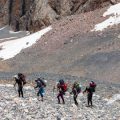Essential Winter Hiking Footwear
The Importance of Proper Boots for Winter Trails
When hiking snowy American trails, your feet are your most valuable asset. Having the right winter boots can make or break your adventure. Insulated and waterproof boots are a must-have for winter hikes in the U.S., from the Rockies to the Appalachians. Not only do they keep your feet warm, but they also protect you from slushy snow, icy puddles, and freezing temperatures.
Key Features to Look For
| Feature | Why It Matters |
|---|---|
| Insulation | Keeps your feet warm in subzero temps; look for Thinsulate or PrimaLoft linings. |
| Waterproofing | Prevents melting snow and slush from soaking your socks; Gore-Tex membranes are popular. |
| High Ankle Support | Helps prevent snow from getting inside and offers stability on uneven terrain. |
| Rugged Outsoles | Provides better grip on slick trails covered with ice or packed snow. |
Traction Devices: Microspikes & More
Even the best boots need a little backup when it comes to icy conditions. Traction devices like microspikes or Yaktrax slip easily over your boots and give you extra grip on hard-packed snow and ice patches. These are essential for many U.S. trails where winter conditions can change fast, especially in places like the Pacific Northwest or New England.
Popular Traction Devices for American Trails:
- Microspikes: Small metal spikes that provide great grip on icy paths.
- Yaktrax: Coil systems that work well for lighter snow and urban trails.
- Crampons: For steeper, more technical mountain hikes (like the Rockies).
Tips for Keeping Feet Warm and Dry
- Wear moisture-wicking socks: Wool or synthetic blends help pull sweat away and keep your toes cozy.
- Pace yourself: Too much sweating can chill your feet later, so adjust layers as needed.
- Avoid cotton socks: Cotton holds moisture and will leave your feet cold.
- Tuck pants into boots or use gaiters: This keeps snow out and warmth in, especially in deep drifts common in American backcountry areas.
- Carry an extra pair of socks: If your feet get wet, a dry pair can save the day on the trail.
2. Layering Up: Clothing for Cold Weather
When it comes to winter hiking on American trails, dressing in layers is the key to staying warm, dry, and comfortable. Weather can change fast—one minute you’re in the sun, the next you’re facing snow flurries or icy winds. Here’s a quick guide to the essential clothing layers every hiker should have:
Understanding the Layering System
The classic three-layer system lets you adjust your gear as conditions change:
| Layer | Main Purpose | Popular American Favorites |
|---|---|---|
| Base Layer | Wicks sweat away from skin | Thermal tops and bottoms (merino wool or synthetic) |
| Mid Layer | Insulates and retains body heat | Fleece jackets, lightweight down or synthetic puffy coats |
| Outer Shell | Blocks wind, rain, and snow | Waterproof/breathable jackets & pants (like Gore-Tex shells) |
Base Layers: Your First Line of Defense
Start with a snug-fitting thermal base layer made from merino wool or high-quality synthetics. Cotton is a no-go—it holds moisture and will leave you shivering. Top picks among American hikers include Smartwool and Patagonia Capilene for their warmth and quick-dry abilities.
Mid Layers: Fleece & Puffy Jackets
Your mid layer provides insulation. Fleece jackets are a classic favorite—they trap warmth but breathe well if you start to overheat. For colder days, add a down or synthetic puffy jacket. Down is super warm but loses its insulating power when wet; synthetic options like Primaloft stay warm even if they get damp.
Outer Shells: Keeping Out the Elements
An outer shell protects you from wind, snow, and rain. Look for waterproof and breathable materials like Gore-Tex or eVent. Features such as adjustable hoods, pit zips, and roomy pockets are popular with American hikers who want comfort and convenience on the trail.
Extra Tips for American Trails
- Mismatched weather? Always pack an extra layer in your backpack—conditions can swing wildly from trailhead to summit.
- Avoid sweating: Remove layers before you start overheating; its easier to stay warm than to get warm again after sweating.
- Add accessories: Warm hats, neck gaiters, and waterproof gloves are must-haves for full protection.
The right layering system gives you the flexibility to handle whatever Old Man Winter throws your way on America’s beautiful trails!

3. Backpacks & Storage Solutions
When winter hiking in the US, having the right backpack and storage setup can make or break your adventure. Cold-weather treks mean you’ll need to carry extra layers, more food, and sometimes specialized gear like snowshoes or microspikes. Here’s what to look for when picking a winter-ready pack—and how to keep your essentials organized and accessible, even when you’re wearing gloves.
Choosing a Winter-Appropriate Backpack
Winter packs are different from your typical summer daypack. They offer more volume, tougher materials, and features designed for snow and ice conditions. Check out the table below for key features:
| Feature | Why It Matters |
|---|---|
| Extra Volume (30-50L) | Room for bulky jackets, insulated bottles, and emergency gear |
| Ski/Snowshoe Carry Straps | Attach extra equipment securely on the outside of your pack |
| Water-Resistant Materials | Keeps snow and moisture out, protecting your gear |
| Easy-Access Pockets | Grab snacks or gloves quickly without digging through everything |
| Padded Hip Belt & Shoulder Straps | Makes heavy loads more comfortable over long miles |
Hydration Systems That Won’t Freeze
Staying hydrated is just as important in cold weather—but your water supply can freeze if you’re not careful. Look for hydration reservoirs with insulated tubes or wide-mouth bottles that are easy to refill and less likely to freeze solid. Some hikers keep their water bottles upside down in their packs; since water freezes from the top, this trick helps keep the opening ice-free.
Popular Options for Hydration:
- Insulated hydration bladders: Many brands offer tubes with sleeves to prevent freezing.
- Nalgene-style wide-mouth bottles: Durable, easy to open with gloves on, and compatible with bottle insulators.
- Thermos-style vacuum bottles: Great for keeping drinks hot or unfrozen all day.
Organizing Your Essentials in Cold Weather
The key to efficient winter packing is accessibility and organization. Use stuff sacks or zippered pouches to group items by category—think first aid, snacks, electronics, or spare socks. Always store items you may need quickly (like headlamps or hand warmers) in exterior pockets. Pro tip: Label your bags with tape so you don’t have to fumble around when your fingers are numb.
Quick Tips for Smart Winter Packing:
- Keep electronics close to your body to protect batteries from the cold.
- Pack a small dry bag for wet or snow-covered gear.
- Cinch down compression straps to stabilize heavy loads.
- Avoid overpacking—bring only what you need but always be ready for emergencies.
A well-chosen backpack and smart storage habits help keep your winter hike safe and enjoyable on American trails—no matter how wild the weather gets!
4. Safety Gear and Navigation Tools
When it comes to winter hiking on American trails, especially in mountainous regions, having the right safety gear and navigation tools is just as important as your boots or jacket. Unpredictable weather, shorter daylight hours, and rugged terrain all mean you need to be prepared for anything. Here’s a look at essential items every hiker should pack:
Essential Safety Gear for Winter Hikes
| Item | Why You Need It | Pro Tip |
|---|---|---|
| Headlamp | Winter days are short, so reliable lighting helps you find your way after dark. | Bring extra batteries—cold drains power fast! |
| GPS Device | Keeps you on track when snow covers trail markers or if visibility drops. | Choose one with offline maps and weather resistance. |
| Trail Map & Compass | Always carry a paper map and compass as a backup for electronics. | Practice using them before hitting the trail. |
| Emergency Blanket | Packs small but can save your life by retaining body heat if you’re stranded. | Look for reflective mylar types—they double as a signaling device. |
| Avalanche Safety Gear* | If you’re hiking in avalanche-prone areas like the Rockies or Cascades, bring a beacon, probe, and shovel. | Take an avalanche safety course before venturing into risky zones. |
*Avalanche Awareness Is Key!
If you plan to hike in areas known for avalanches, always check local conditions first. Even experienced hikers should never underestimate this risk—your safety gear only works if you know how to use it.
Packing Smart for American Trails
The American wilderness can be both beautiful and unforgiving during winter. Having these tools handy means you’re better prepared for whatever comes your way, from sudden whiteouts in the Adirondacks to chilly nights in the Rockies. Double-check your pack before leaving home—these simple items could make all the difference on the trail.
5. Winter Nutrition & Hydration Strategies
High-Energy Snacks for Cold-Weather Trails
Staying fueled on winter hikes is all about packing the right snacks. American hikers often reach for foods that are calorie-dense and easy to eat, even with gloves on. Here’s a quick look at popular choices:
| Snack | Why It’s Great for Winter Hiking |
|---|---|
| Trail Mix (nuts, dried fruit, chocolate) | Packs lots of calories; won’t freeze solid; easy to munch on the go |
| Energy Bars (Clif, RXBAR, KIND) | Compact; stays edible in cold temps; quick energy boost |
| Jerky (beef, turkey, plant-based) | High protein; satisfies hunger; doesn’t spoil easily |
| Peanut Butter Packets | Loaded with healthy fats and protein; squeezable and portable |
| Candy (M&Ms, Snickers minis) | Sugar rush for fast energy; still soft enough to chew in the cold |
Hot Beverage Containers: Stay Warm, Stay Motivated
A hot drink can make all the difference on a chilly hike. Insulated thermoses are a staple in many American hikers’ packs. Look for bottles from trusted brands like Hydro Flask or Stanley that keep liquids hot for hours. Fill yours with coffee, tea, or hot cocoa—just avoid glass containers since they can crack in freezing temps.
How to Prevent Your Water from Freezing
- Insulated Bottles: Use double-walled insulated bottles or sleeves to keep water from turning to ice.
- Bottle Positioning: Carry bottles upside down so if ice forms, it’s at the bottom near the lid (makes opening easier).
- Hydration Bladders: Use insulated tubes or blow air back into the tube after each sip to prevent freezing.
- Add Warm Water: Start with hot (not boiling) water—it’ll stay liquid longer.
- Pocket Placement: Keep smaller bottles close to your body inside your pack or jacket to use your body heat.
Key Tips for Staying Fueled in Winter Conditions
- Snack Regularly: Eat small amounts every 30–60 minutes—even if you’re not hungry—to keep energy levels up.
- Avoid Dehydration: Cold air makes you less thirsty but you’re still sweating—sip often!
- No Frozen Snacks: Avoid items that become too hard or brittle in the cold (some bars get rock solid below freezing).
- Add Electrolytes: If you’re hiking long distances, supplement with electrolyte tablets or powders for balanced hydration.
- Plan Ahead: Pre-cut or pre-open wrappers before you hit the trail—cold fingers make everything harder!
Your Winter Fueling Checklist
- Packed high-calorie snacks?
- Thermos filled with your favorite hot drink?
- Bottles protected from freezing?
- Easy-to-reach snacks stashed in pockets?
- An extra snack or two just in case?


